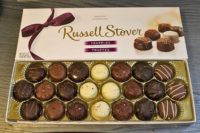
Thomas Linemayr (left), president of Lindt USA, and Ernst Tanner, chairman and ceo of Lindt & Sprüngli AG, hold up several Excellence line of thin chocolate bars at the company's retail store in Stratham, N.H.
They make a formidable duo, Ernst Tanner and Thomas Linemayr. As chairman and ceo, Tanner took a sleepy Lindt and Sprüngli AG that was doing business primarily in three European countries in 1994 and transformed it into a global multinational, doing more than $2.5 billion in 100 markets.
Upon joining Lindt USA in 1999, Linemayr posted 10 solid years of high-paced growth for the company, making it the U.S. premium chocolate category leader with a market share of nearly 30%.
Formidable numbers, indeed. But when asked whether they were surprised at how quickly and easily success had come, both shook with laugher. Not so quickly, nor so easily. Tanner quickly pointed to his gray hair. Establishing Lindt USA as the dominant premium chocolate maker in the world’s largest confectionery market didn’t come without significant investment and risk-taking.
“As a company [Lindt & Sprüngli AG], we were wrestling with the idea of whether we should stay in the United States or focus on Europe,” he says. Sales back then in 1996 totaled $20 million, Tanner points out. And as far as the premium chocolate category goes, it represented less than 1% of the total chocolate market, the bulk coming from specialty stores.
By installing Linemayr as head of Lindt USA in 1999 and committing serious monies to developing the segment, everything from opening up more than 100 retail stores to spending well in excess of $100 million on its production facility in Stratham, N.H., Tanner set in motion the growth strategy. Under Linemayr’s direction, Lindt USA not only expanded the premium category, it came to dominate it.

Alvaro Delacruz inspects positioning of Lindor Truffles as they head toward a filling depositor and then demoulding.
Moreover, since 2000, Lindt USA has consistently put up double-digit sales gains, Linemayr affirms.
“As the leader in the category, we’re responsible for category growth,” he adds.
And despite the recession having a dampening effect on confectionery sales, including the premium category, Linemayr foresees another double-digit posting for 2009.
“Consumers are cutting back on volume, but they’re looking for higher quality,” Linemayr says. “Most retailers have cut back their inventory level this year. They’re dependent on demand. In our case, demand for our products has been extremely strong.
“We see opportunities in the premium segment,” he continues. “Some of our competitors have been struggling. As a result, we’re going to attack the marketplace, enhance our support programs during the second half of the year. We’re going to maintain our strategy for a long-term focus.”
That long-term focus, which dates back to the company’s inception in 1845, has been on premium products for the masses.
“We price our products so that they are affordable for everyone,” Tanner says. What differentiates premium quality from run-of-the-mill quality begins with sourcing of the beans and continues through cleaning, winnowing, roasting and conching, he adds.
“We treat our cocoa beans like a jewel, and not as an ingot in a steel mill,” the chairman explains.
That provides Lindt with enormous credibility with both consumers and customers, Linemayr adds. He also points out that there have been many competitors who jumped into the premium chocolate segment, eager to take advantage of the growth surge that began back on 2004. But they have jumped out almost as quickly.
“For us premium is not an attribute; it’s in our DNA,” Linemayr emphasizes. “After all, we’ve been doing nothing else for more than 160 years.”
Tanner echoes those sentiments, noting that “pride, passion and commitment to producing the best premium chocolate is embedded in the genes of all of our 7,000 employees.”
That same pride, passion and commitment extend to upper management; together, Tanner and Linemayr have nearly 30 years of service with Lindt. And while anyone pouring over Lindt USA’s numbers might wonder if the process was an automatic one, simply taking advantage of a growing sophistication of the American palate, both executives can attest to the challenges overcome and those awaiting them.

Michael Staniec, mass mould manager, checks on an ACMA wrapping maching capable of handling up to 1,050 Lindor truffles per minute.
The establishment of retail stores also helped introduce consumers directly to the company’s broad range of products. At one point, the company operated 106 stores across major metropolitan areas, each building brand equity and introducing consumers to Lindt’s nearly limitless stable of chocolate items.
“The stores proved invaluable, allowing us to convince customers to list our products much faster,” Tanner says. Such success, however, eventually contributed to the stores’ own undoing.
Inevitably, wherever there was a Lindt retail store located in a mall, there were four or five retail shops selling Lindt products. That, coupled with the onset of the recession in 2008 and the prospect of renewing 10-year leases at much higher rates, prompted the company to make a tough but necessary business move: consolidation. By year’s end, Lindt USA will close many of its retail units, leaving it with about 70 stores.
“The worst thing is not to make a decision,” Tanner says. “We closed stores that were losing money and are going to reinvest those monies into advertising and point-of-sale activities. The best marketing investment we can do is to let people sample our products. Once an American consumer puts aLindor Truffle in their mouth, chances are that they’ll be a loyal consumer.”
Such confidence stems from the company’s adherence to producing chocolates that deliver “an eating experience.” As Tanner points out, the American consumer has grown increasingly sophisticated in making food choices, be it for coffee, wine or chocolates.
“And they [American consumers] reward quality,” Linemayr adds.
Thus, in addition to exacting standards and processes involving the sourcing of cocoa beans - Ghana and Ecuador are the two main suppliers - the company equally devotes time, detail and money to chocolate processing and packaging.

“We’ve invested more than $100 million here as well as in our Ghirardelli plant in San Leandro, Calif.,” Tanner says. In 2007, the company completed a 350,000 sq. ft. addition in Stratham, which consisted of 250,000 sq. ft. devoted to warehousing and 100,000 sq. ft. for packaging.
In completing the new packaging area, the company was able to take advantage of the previous packaging area, about 35,000 sq. ft. in size, and reconfigure it for a new chocolate bar line slated to begin operation on August 4.
The 472-ft. long moulding line, which was custom-designed for Lindt by Bindler/Buhler, can handle both solid and filled bars, 30 and 35 moulds per minute, respectively, says Manuel Wildberger, v.p. of operations.
Engineered with an eye to flexibility, the new line is projected to produce 20,000 bars an hour - about 200,000 bars during a 10-hour shift. Current plans call for the new line to handle 16 different bars in Lindt’s USA lineup, everything from theLindt Classic line, featuring inclusions such as hazelnuts, almonds and raisins, to the super thin Excellence line that includes 50%, 70%. 85% and 90% cocoa content as well as White Coconut, Orange Intense, Mint Intense and Chili Intense varieties.
On the packaging end, there will be three Loeschpack wrapping machines featuring automated roll-changing devices and right/left-handed options, Wildberger adds. Depending upon the product, the wrappers can accommodate between 100 and 125 bars per minute.
For Lindt, the advantage of having packaging machines that can be oriented to right- and left-handed operations enables the company to use one operator for both units while also providing space-saving considerations, points out Urs Wigger, director of process transfer & training.
The production of bars in the United States marks a significant milestone for the company, one that dovetails with its continued growth in the premium segment.
As Larry Fineburg, v.p. of sales, points out, the new bar line enhances Lindt USA’s flexibility.
“We don’t have to wait 100 days for a bar order to arrive, which puts an onus on forecasting correctly,” he says.

Larry Fineburg, v.p. of sales, says the company will greatly expand its marketing push during the coming months.
The new bar line and accompany packaging, however, aren’t the only spectacular investments at the Stratham facility. To meet increased demand for chocolate, the company had to pump up its cocoa mass processing and refining capacity.
“We needed to feed the new bar line with chocolate,” Wildberger says. Housed within a four-story tower that takes advantage of gravity flow, the new building features holding bins, a mixer, a pre-refiner, three refiners and three 6-ton conches, all supplied by Frisse/Buhler. The fully automated system - it requires only a single operator to supervise production - came online last fall.
But perhaps the most exciting news for Lindt USA is the pending installation of a cocoa roasting operation in late March 2010.
The 35,000-sq.-ft. roasting facility will mark another milestone for the company, making the Stratham plant a bean-to-bar operation. All the cleaning, roasting, winnowing and mixing equipment, as well as the holding tanks, will be supplied by Buhler.
“The U.S. consumer will have the best of both worlds - premium Swiss recipes made in the United States,” Tanner says. “What else can you ask for? Thanks to our experience, we will be producing the same quality product found in Switzerland, but right here in the United States.”
There are also ecological and efficiency benefits that spring from this investment, Linemayr adds.
“In the past, we would source the beans from Ecuador and Ghana and then have them shipped to Holland, where they would travel on the Rhine River to Switzerland,” he says. After processing, the cocoa mass (liquor) would be shipped to the United States as 2,200-lb. blocks, where they would be melted down for further processing. By shipping the beans directly to Stratham, the carbon footprint has been significantly reduced.
Moreover, Lindt’s famed quality control remains intact.
“Few companies can control the final product from the bean to the packaged item,” Linemayr emphasizes. “This has a major impact on the quality of the product.”
Also, few companies have access to such a wealth of products. Thanks to ongoing research and development at Lindt & Sprüngli’s headquarters, as well as its subsidiaries globally, Lindt USA can pick from a broad selection of products.
As Fineburg notes, “We set the trends in the premium category.” He cites Lindt’s standup bags, the vertical thin bar and labeling of cocoa content as just a few examples. This year, the company introduced several new items at theALL CANDY EXPO, including anExcellence Touch of Sea Salt bar,Excellence 50% and 90% cocoa content bars and theClassic RecipesRaisins and Nuts bar. Last year, the company debuted itsStracciatella Lindor line.
All the launches have been well-received, says Fineberg, with theStracciatella Lindortruffles “doing very well. There’s huge potential for white chocolate sales, particularly when it’s a premium offering like ours.”
Lindt USA has more in the works, of course. This fall, the company will unveil its newGrandeur line - a thicker, 150-gram bar that contains caramelized hazelnuts and almonds in milk, dark and white chocolate varieties.

With the completion of a new 35,000-sq.-ft. roasting facility first quarter, 2010, Lindt USA will become a bean-to-bar manufacturer.
“We believeGrandeur will have the highest nut content of any bar on the market,” Linemayr says. “In addition, it’s a totally different eating experience, appealing to those consumers who are ‘biters’ and like chunky bars.”
The company also will unveil its newPetite DessertsMousse Bars. Using proprietary technology that took two and a half years to develop and perfect, the new line features an aerated and fluffy mousse filling that delivers an “intense taste experience.”
“It’s really exceptional, evoking the experience you have consuming a chocolate mousse dessert,’ Linemayr says.
Seasonal products also remain a critical component of the company’s lineup, Melanie Leyden, director of seasonal marketing, says. This year, Easter sales surged 28% from last year. And while Leyden acknowledges that the later selling date helped, quality offerings did their part. She draws attention to the company’sGold Bunny, which officially took over the No. 1 ranking within the chocolate bunny category this year.
She forecasts a strong second half for the company, noting that marketing and advertising spending will hit “unprecedented levels.”
“There are many manufacturers that are pulling back,” Leyden says. “We think that now is the right time and the right opportunity to continue to build brand awareness as well as increase trial opportunity. Our goal is to build market share.”
To compliment the new product launches, the company will increase its television presence as well as its online activity, trade marketing, point-of-sale marketing and brand communication efforts.
The reason behind such intense marketing and advertising spending? Again, it’s all about capitalizing on Lindt’s positioning and its strategy to expand market share.
“You will see acceleration in the growth of the premium sector for years to come,” Tanner asserts. “Consumers worldwide want more quality, less quantity.”
To that end, both executives foresee Lindt USA topping $1 billion in sales by 2013.
A formidable goal. But than neither of the two executives would want it any other way.

At a Glance
Lindt USAHeadquarters: Stratham, N.H.
2008 Sales: $500 million (includes Ghirardelli)
Employees: 650 (includes temporaries during peak season)
Plant: 650,000 sq. ft. (includes offices, warehousing, production and cocoa roasting), four Lindor truffle lines, one bar line.
Products: Chocolate truffles, chocolate bars.
Brands:Lindt,Lindor,Lindt Excellence,Lindt Classic Recipes,Lindt Petits Desserts.
Retail stores: 70 (end of 2009)
Sales breakout: 76% - milk chocolate; 14% - dark chocolate; 8.5% - assorted; 1.5% -white chocolate.
Management team: Ernst Tanner, chairman and ceo; Thomas Linemayr, president; Manuel Wildberger, v.p. of operations; Lawrance Fineburg, v.p. of sales; Urs Wigger, director of process transfer & trading; Melanie Leyden, director of seasonal marketing; Danielle LaChance, marketing manager.



